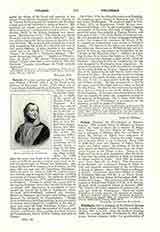

Pulcheria, Saint, Empress of the Eastern Roman Empire, eldest daughter of the Emperor Arcadius, b. January 19, 399; d. in 453. After the death of Arcadius (408), her younger brother, Theodosius II, then only seven, became emperor under the guardianship of Anthimus. Pulcheria had matured early and had great administrative ability; she soon exerted salutary influence over the young and not very capable emperor. On July 4, 414, she was proclaimed Augusta (empress) by the Senate, and made regent for her brother. She made a vow of virginity and persuaded her sisters to do the same, the imperial palace thus becoming almost a monastery (Socrates, “Hist. eccl.”, VII, xxii). At the same time she fulfilled all her duties as a ruler for about ten years jointly with her brother. After the marriage, brought about by Pulcheria, of Theodosius II with Eudoxia, the new empress sought to weaken Pulcheria’s influence over the emperor, and, with the aid of some courtiers, succeeded for a time. Nevertheless, Pulcheria had always a powerful position at Court, which she used in behalf of ecclesiastical orthodoxy, as shown by her opposition to the doctrines of Nestorius and Eutyches. Eudoxia supported Nestorius. St. Cyril of Alexandria sent Pulcheria his work “De fide ad Pulcheriam”, and wrote her on behalf of the true Church doctrine, to which she held unwaveringly (letter of Cyril in Mansi, “Coned. coll.”, IV, 618 sqq.). He also wrote to Eudoxia (ibid. 679 sq.). Theodosius allowed himself to be influenced by Nestorius to the prejudice of Cyril, whom he blamed for appealing to the two empresses (ibid., 1110). Pulcheria, however, was not deterred from her determination to work against Nestorius and to persuade the emperor to espouse Cyril’s party which favored the definition of the Council of Ephesus. In the further course of the negotiations over the Council of Ephesus, the Patriarch of Alexandria sought to gain Pulcheria’s zeal and influence for the union and sent her presents as he did to other influential persons at the Court (Mansi, loc. cit., V, 987 sq.). There is no doubt that the final acknowledgement by the emperor of the condemnation of Nestorius was largely due to Pulcheria. The Nestorians, consequently, spread gross calumnies about her (Suidas, s.v. Pulcheria). Court intrigues obliged her (446) to leave the imperial palace and retire to a suburb of Constantinople, where she led a monastic life. When the Empress Eudoxia went to Jerusalem, Pulcheria returned (about 449) to Court. At the emperor’s death (July 28, 450) she was proclaimed empress, and then married the able general, Marcian, but with the condition that her vow of virginity should be respected. At her order Marcian was proclaimed Augustus.
Meantime, at Constantinople, Eutyches had announced his heresy of the unity of the natures in Christ, and the Patriarch Flavian had expressed his opposition, as did also Pope Leo I. Once more Pulcheria took up the cause of the Church. On June 13, 449, the pope had written both to Pulcheria and to Theodosius, requesting them to end the new heresy (“Leonis epist.”, xxx, in Migne, LVI, 785 sq.). Nine other letters followed. Theodosius II confirmed the decisions of the Robber Synod of Ephesus (449) and the pope, who had rejected them, sought to bring the emperor back to orthodox opinions. On October 13, 449, he wrote again to the emperor and also to Pulcheria (Epist. xlv), begging the latter for aid. The Roman Archdeacon Hilarius also wrote with the same object (Epist. xlvi in “Leonis Epist.”), and at Leo’s entreaty Valentinian III of the Western Empire, with Eudoxia and Galla Placidia, wrote to Theodosius and Pulcheria (Epist. lviii). Another letter to Pulcheria was sent by Leo on July 16, 450 (Epist. lxx). After the death of Theodosius, conditions were at once changed. Marcian and Pulcheria wrote to Leo (Epist. lxxvil). She informed him that the Patriarch Anatolius had expressed his approbation and had signed the papal letter to Flavian concerning the two natures in Christ. She requested the pope to let it be known whether he would attend personally the council that had been summoned. The empress was influential in the Council of Chalcedon (451) and with the emperor attended the sixth session (October 25, 451). Leo in his letter of April 13, 451 (Epist. lxxix), wrote Pulcheria that both the Nestorian and Eutychian heresies had been overcome largely by her efforts. He thanked her for the benefits she had bestowed on the Church, for her support of the papal legates, for the recall of the banished Catholic bishops, and for the honorable burial of the body of the Patriarch Flavian. Pulcheria showed no less zeal in promoting other interests of the Church. She built three churches in Constantinople in honor of Mary the Mother of God; one, erected after the condemnation of the Nestorian heresy, was exceedingly beautiful. In other places also she built churches, hospitals, houses for pilgrims, and gave rich gifts to various churches (Sozomen, “Hist. eccl.”, IX, i). She had the bones of St. John Chrysostom, who had died in exile, brought back to Constantinople and buried in the church of the Apostles on January 27, 438; this led to the reconciliation with the Church of the schismatic party of the Johannines (Socrates, “Hist. eccl.”, VII, xlv). Pulcheria had the relics of the forty martyrs of Sebaste, which were found near Constantinople, transferred to a church (Sozomen, “Hist. eccl.”, IX, ii). She is venerated as a saint in the Greek and other Oriental Churches as well as in the Latin Church. Her feast is given under September 10 in the Roman Martyrology and in the Greek Menaia; in the other Oriental calendars it is under August 7
J. P. KIRSCH

